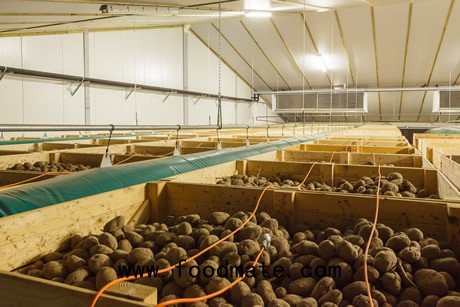Developments in cooling systems
In the last 5 years there has been a lot of development in the area of new cooling systems. Due to tightened environmental demands and new technological developments, cooling installations have entered the market which have a number of advantages for the product. Until a few years ago mechanical cooling systems were mainly direct systems (1 cooling ring with refrigerant evaporating directly in the air cooler with the product) with a set temperature over the air cooler. The problem with this was that only one type of product (potatoes or onions) could be optimally cooled. For other types of product the cooling installation isn't suitable as there isn't enough cooling power available or it is too dry.
The new cooling systems are the so called indirect systems that consist of two circles. In the first ring outside of the storage place a small amount of refrigerant (propane or NH3) is used which evaporates in a heat exchanger. This ensures the cold carrier (i.e. glycol or CO2) from the second circle is cooled down which is then pumped to the air cooler in the storage and absorbs heat from the product. By varying the volume flow and/or the temperature of the cold carrier the cooling power and dehydration can be adjusted to the demands of the product. This ensures the eventual storage turnover is increased and it is possible to store different types of products. Comparative practical tests in carrots and potatoes have shown that use of an indirect cooling installation can reduce the weight loss by 30%. Here only 2% of weight loss was measured over a storage period of 7 months in the indirect cooling system and 3% of the direct cooling system.

By splitting the cooling ring into 2 parts, other refrigerants come into the picture which have good cooling properties and less effect on the environment. This is also a demand in international law for cooling.
Comparing and designing cooling systems
It isn't simple to just a cooling system on quality based on only its cooling ability. A cooling system can have a lot of cooling power but due to this dry out the product too much at the same time. By installing more air coolers and working with a smaller temperature difference, the same cooling power is available and that provides less weight loss. To be able to properly judge a cooling system a number of main characteristics are important: cooling power per tonne of product at a certain storage temperature and outside temperature, dehumidifying per hour, absorbed electric power relative to the cooling power provided and the possibility of (automatically) adjusting the cooling power to the needs of the product. A cooling installation with a certain cooling power can be designed in a number of ways. By choosing specific components an installation is designed that falls into a category such as: minimal purchasing prices, energy efficiency, minimal dehydration, flexible usage. By paying more or less attention to these categories, difficult to compare installations can be placed side by side with the same cooling capacity. Mechanical cooling is a strongly specialist area of work in which during the design process a lot of knowledge has to be exchanged between storage specialist and grower.
Modern climate control
Besides the cooling installation itself, the regulation of the entire installation is also an important factor in the final storage turnover. As modern climate computers become available with large touchscreens and are connected to the internet, the function and ability of the installation can be presented to the user with oversight. This also offers the opportunity to quickly signal when installations have to be adapted. At a technical level is also easy to analyse how the installation is functioning based on the information shown (temperatures and pressures).
An integrated control of the (outside air) ventilation system and the mechanical cooling installation by one climate computer ensure an optimal collaboration that further improves the storage turnover. A new interesting control possibility is automatically adapting the cooling power to the demands of the product. A lot of cooling power can be supplied automatically during the cooling process and with the same installation minimal dehydration can be achieved during the storage phase. In the future it will even be possible to organise and steer the installation based on product quality with new sensor technology.






